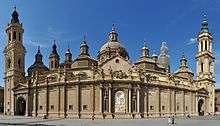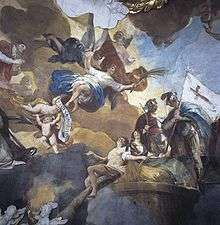Cathedral-Basilica of Our Lady of the Pillar
Coordinates: 41°39′25″N 0°52′42″W / 41.65694°N 0.87833°W
| Cathedral-Basilica of Our Lady of the Pillar Catedral-Basílica de Nuestra Señora del Pilar | |
|---|---|
.jpg) Nuestra Señora del Pilar Basilica | |
| Basic information | |
| Location | Zaragoza, Spain |
| Affiliation | Catholic |
| Rite | Roman Rite |
| Province | Archdiocese of Zaragoza |
| Country | Spain |
| Year consecrated | 1st or 2nd century AD |
| Ecclesiastical or organizational status | Minor Basilica |
| Architectural description | |
| Architectural style | Baroque |
| Groundbreaking | 1681 |
| Completed | 1754 |
The Cathedral-Basilica of Our Lady of the Pillar (Spanish: Catedral-Basílica de Nuestra Señora del Pilar) is a Roman Catholic church in the city of Zaragoza, Aragon, Spain. The Basilica venerates Blessed Virgin Mary, under her title Our Lady of the Pillar[1] praised as "Mother of the Hispanic Peoples" by Pope John Paul II.[2] It is reputed to be the first church dedicated to Mary in history.[3]
Local traditions take the history of this basilica to the dawn of Christianity in Spain attributing to an apparition to Saint James the Great, the apostle who is believed by tradition to have brought Christianity to the country.[4] This is the only reported apparition of Mary to have occurred before her believed Assumption.[2]
Many of the kings of Spain, many other foreign rulers and saints have paid their devotion before this statue of Mary. Saint John of the Cross, Saint Teresa of Ávila, Saint Ignatius of Loyola, and Blessed William Joseph Chaminade are among the foremost ones.[5] The Basilica of Our Lady of the Pillar is one of two minor basilicas in the city of Zaragoza, and is co-cathedral of the city alongside the nearby La Seo Cathedral. The architecture is of Baroque style, and the present building was predominantly built between 1681 and 1872.
History

Apparition of Pilar
According to ancient local tradition, soon after the crucifixion and resurrection of Jesus, Saint James was preaching the Gospel in Spain, but was disheartened because of the failure of his mission.[4] Tradition holds that on 2 January 40 AD,[3] while he was deep in prayer by the banks of the Ebro,[6] the Mother of God appeared to him and gave a column of jasper and instructed him to build a church in her honor:[4]
This place is to be my house, and this image and column shall be the title and altar of the temple that you shall build.
First Chapel
About a year after the believed apparition James is believed to have arranged to build a small chapel in Mary's honor, the first church ever dedicated to the honor of the Virgin Mary. After James returned to Jerusalem, he was executed by Herod Agrippa in about 44 AD, the first apostle to be martyred for his faith. Several of his disciples took his body and returned it for final burial in Spain.[4] This first chapel was eventually destroyed with various other Christian shrines, but the statue and the pillar stayed intact under the protection of the people of Zaragoza.[5]
Expansions
Romanesque Church
Numerous churches have been built upon this site through the years. The tiny chapel built by Saint James later gave way to a basilicalike enclosure during Constantine I's time; subsequently being transformed into Romanesque, then Gothic then Mudéjar styles.[7] The venerated shrines at Zaragoza date to the Christian Reconquest by King Alfonso I in 1118.[8] A church in the Romanesque style was built under the pontificate of Pedro de Librana[7] who is also credited with the oldest written testimonial to the Virgin at Zaragoza.[6] A tympanum on the south wall of this Romanesque church still stands.[7]

Gothic Church
The Romanesque church was damaged by fire in 1434, and reconstruction began in the Mudéjar Gothic style.[7] A Gothic-style church was built in the 15th century but only a few parts of it remain intact or were later restored, including the choir stand and the altarpiece in alabaster by Damián Forment.[9]

Current church
The present spacious church in Baroque style was begun in 1681[6] by Charles II, King of Spain and completed in 1686.[5] The early constructions were supervised by Felipe Sanchez[7] and were later modified by Francisco Herrera the Younger under John of Austria the Younger.[10] In 1725, the Cabildo of Zaragoza decided to change the aspect of the Holy Chapel and commissioned the architect Ventura Rodríguez, who transformed the building into its present dimensions of 130 meters long by 67 wide, with its eleven cupolas and four towers. The area most visited is the eastern part of the chapel, because this is where the Holy Chapel by Ventura Rodríguez (1754) is built, which houses the venerated image of the Virgin. Around the Holy Chapel are the vaults or domes painted with frescoes by Francisco Goya: The Queen of Martyrs and Adoration of the Name of God.[9] By 1718 the church had been vaulted over. However, it was not until 1872 that the final touches were put to these vaults, when the main dome and the final spire were finished.[7]
During the Spanish Civil War of 1936–1939 three bombs were dropped on the church but none of them exploded.[3] Two of them are still on show in the Basilica.
Notable choirmasters include the Baroque composer Joseph Ruiz Samaniego.
Pillar and the image

The statue is wooden and 39 cm tall and rests on a column of jasper. The tradition of the shrine of El Pilar, as given by Our Lady in an apparition to Sister Mary Agreda and written about in The Mystical City of God, is that Our Lady was carried on a cloud by the angels to Zaragoza during the night. While they were traveling, the angels built a pillar of marble, and a miniature image of Our Lady. Our Lady gave the message to St James and added that a church was to be built on the site where the apparition took place. The pillar and the image were to be part of the main altar.[2] The image was crowned in 1905 with a crown designed by the Marquis of Griñi, and valued at 450,000 pesetas (£18,750, 1910).[6]
Layout
The building, which can be seen from the nearby Ebro River, is a large rectangle with a nave and two aisles, with two other all-brick chapels, thus giving the whole a typically Aragonese touch. It is illuminated by large oculi, characteristic of the monuments of the region from the 17th century onwards. Twelve enormous pillars support the vaults of the nave and aisles; the whole is topped by domes, as are the chapels.[7]
The chapels within the Basilica include:
- Chapel of the Rosary
- Chapel of Joachim
- Chapel of Saint Lawrence (Lorenzo)
- Chapel of Saint Pedro de Arbués
- Chapel of Saint Braulio
- Chapel of Saint Anthony
- Chapel of Saint Joseph
- Chapel of Saint Anna
- Chapel of Saint John
El Pilar and Spanish identity
The feast of Our Lady of the Pillar, celebrating the first apparition of Mary to Hispanic people, is on October 12. This coincides with the Día de la Hispanidad and the date of Columbus's discovery of the New World. Every nation of Hispanic colonial origin has donated national vestments for the fifteenth-century statue of the Virgin, which is housed in the chapel.[7] Pope John Paul II praised El Pilar as "Mother of the Hispanic Peoples" during both his visits to the Basilica.[2]
It was declared Bien de Interés Cultural in 1904.
See also
| Wikimedia Commons has media related to Catedral-Basílica de Nuestra Señora del Pilar de Zaragoza. |
- Marian apparitions
- Roman Catholic Marian churches
- 12 Treasures of Spain
- List of Bien de Interés Cultural in the Province of Zaragoza
References
- ↑ Our Lady of the Pillar Archived 2007-10-15 at the Wayback Machine. on Catholic-forums.
- 1 2 3 4 Fr. Tommy Lane Homily during a pilgrimage to Zaragoza, Spain on Bible, Prayer, Homily resources website.
- 1 2 3 NUESTRA SEÑORA DEL PILAR (OUR LADY OF THE PILLAR)
- 1 2 3 4 Our Lady of the Pillar on The work of God website on various apparitions of Mary.
- 1 2 3 Zsolt Aradi The Virgen Del Pilar on Catholic culture.
- 1 2 3 4 Nuestra Señora Del Pilar on Catholic encylopedeia.
- 1 2 3 4 5 6 7 8 Juan Antonio Gracia Gimeno. The Pillar of Saragossa Editorial Escudo de Ora. S.A., ISBN 84-378-1301-8
- ↑ Ibn Bajja, Stanford Encyclopedia of Philosophy.
- 1 2 Basilica del Pilar, Zaragoza, Aragon on Aragon guide.
- ↑ Francisco Herrera (el Mozo, the Younger) in Catholic Encyclopedia.

